 An aura of mystery!
An aura of mystery!

| Egg | Design
Solar Symbols Lines Variations of the Line Cross Churches Plant Motifs Animals |
Color |
Archeologists have discovered ceramic pysanky in Ukraine dating back to 1300 B.C. They have linked pysanky designs to those of Egyptian ceramics created in 1500 B.C., and to symbolism of the Trypillian culture in Ukraine of 3000 B.C. 6000 years ago the Trypillian culture flourished in Ukraine. The society existed 3000 years before biblical Abraham and long before Greek mythology and the Bronze Age. Trypillian people lived in the land of Ukraine at the same time as the Egyptian pyramids were build. The Trypillians were a matriarchal society that worshipped "mother earth" and had little interest in power struggles concerning politics, taxes, money and ruling, as in patriarchal societies. Trypillians lived peacefully with each other and with their neighbors. The tools which were most used were hoes and sickles, not clubs and arrows. Their homes were decorated inside and out with beautiful drawings and paintings. Because they took time for artistic and aesthetic beauty, scientists feel they had enough food and time to spend on higher pursuits such as beauty and art. In both design and color, Trypillian symbolism echoed the people's close attachment to the soil and other elements of nature. Ukrainian symbolic art is based, in large measure, on these early ideograms. The most notable example is the Ukrainian meander or unending line, which denotes the cyclical nature of life. Other examples include such motifs as the circle, cross, stars, dots, matriarchal symbols, wheat, fir tree, horse, stag, horns and bear's paws. What is a symbol on "pysanka"? It is a word picture, an ideogram, a code, containing the secrets of a culture. More effectively than words it reveals feelings: love, happiness, hope, dread ,despair, etc. To those who understand symbolic art, it means something, and to those who cannot decipher the code, it remains a mystery.
The sense of mystery is inherent because each pysanka involves a trinity of symbolisms: the symbolism of the egg itself, the symbolism of design, and the symbolism of color.
 The original source of creation! The Universe! The symbol of
life!
Our planet Earth looks like an egg: crust = shell;
magma = egg white; core = yolk.
The original source of creation! The Universe! The symbol of
life!
Our planet Earth looks like an egg: crust = shell;
magma = egg white; core = yolk.
In the folk life of Ukrainian people, the pysanka possess talismanic
powers. Receipt of a pysanka is not only a token of friendship or esteem
but also brings with it protection from harm. Ukrainian ancestors
believed that pysanky in the home would bring good fortune, wealth, health,
and protection from lightning and fire. Pysanky are said to possess
curative powers for both men and animals. With the acceptance of
Christianity in 988 A.D., the pysanka has been part of the Christian tradition
and Easter ritual. The pysanka came to symbolize the rebirth of man, as
represented by the Resurrection. Beeswax was considered as a
magical ingredient of the writing process. This was entwined with the sun
cult. The wax was made from honey; the honey was collected from flowers;
flowers grew because of the sun.
 Symbolism of
design... The
most ancient symbols are of geometric character. Geometric ideograms
consist of the simplest design elements. Each has its own meaning.
Symbolism of
design... The
most ancient symbols are of geometric character. Geometric ideograms
consist of the simplest design elements. Each has its own meaning.
![]() Solar symbols include variations of the circle, swastika, tripod and star or
rose. The sun and cosmic symbols signify happiness, prosperity and good
fortune.
Solar symbols include variations of the circle, swastika, tripod and star or
rose. The sun and cosmic symbols signify happiness, prosperity and good
fortune.
 |
Circle. It represents completeness, continuity and the cyclical nature of the universe. The pre-Christian interpretation denoted the sun as the center of the universe, the giver of fertility, the victory over evil and darkness. The circle containing a dot is said to represent the moment when the earth receives the light of the sun and comes to life in the spring. In the Christian tradition, the circle may be associated with God because of its perfection and its ability to unite. A circle enclosing the cross represents the millennium, the center and four directions of the universe. The circle cut in two represents polarity such as night and day, summer and winter, life and death. A circle within a circle is said to denote androgyneity. The circle depicted as the poppy denotes consolation, oblivion or sleep; as a spider, the rays of the sun or human frailty. Pre-Christian representations of the circle with symbolic meanings were also seen in the round dances of the spring festivals. |
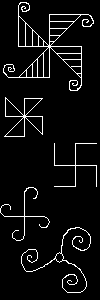 |
Swastika. Is a symbol of happiness, blessings, good fortune and good will. The swastika is often seen
with rounded corners or in the form of the windmill or maltese cross.
The hooks are sometimes stylized to form leaves.
|
 |
Star or Rose. This ideogram is most commonly found in its eight-pointed form. It is one of the most beautiful and versatile of the geometric representations and is said to signify purity, life, the giver of light, the center of all knowledge as well as beauty, elegance and perfection. In the Christian context, the star or rose becomes the herald of Christ's birth, a symbol of God's love toward man. |
 |
Dots. Dots of all sizes represent the stars in the heavens, tears or fixed points that have no beginning or end. They may represent a cuckoo's egg, which is a symbol of spring and carries with it the magical powers of predicting the future. A dot with a circle enclosing it represents the axis of the universe, eternity seen within an egg. |
 |
Triangle. The triangle
is a very basic ideogram and, like the tripod, always signifies a
trinity. In pagan times, the trinity represented was the elemental
air, fire and water or the heavens, earth and air. In Christian symbolism,
the Holy Trinity is most often represented.
|
![]() Lines. Formed by a series of dots, there are many linear variations:
Lines. Formed by a series of dots, there are many linear variations:
 |
Straight Line. The straight line encircling the egg symbolizes eternity or the continuous thread of life. |
 |
Ribbon or Belt. This motif symbolizes eternity and is almost always seen in unbroken form so that the thread of life will not be broken. |
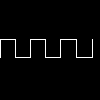 |
Embattled Line. This variation signifies a forest or enclosure, something to be contained. |
 |
Engrailed and Invected Line. This suggests a place of meeting of union of opposites such as land meeting water. |
 |
Indented Line or Saw. This is a common line variation indicating fire as the symbol of the sun or life-giving heat. It may also represent water or waves with its growth and cleansing properties. |
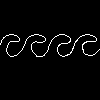 |
Meander. This ancient form of the line is popular in all regions of Ukraine. This motif emphasizes harmony and motion depicting infinity, waves and immortality. |
 |
Gypsy Roads. The meander is a continuous route between two colored fields. Evil is, therefore, unable to find its way off the Gypsy road and harm the recipient of the pysanka. |
![]() Variations of the Line:
Variations of the Line:
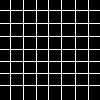 |
Sieve. A very common motif on the beautiful Hutsul pysanky. Is a symbol for dividing good from evil. |
 |
Basket. This ideogram suggests contained knowledge, motherhood as well as the giver of life and gifts. |
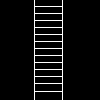 |
Ladder. A motif taken from everyday agricultural life, the ladder is symbolic of searching; rising above the petty problems of life. |
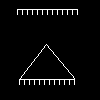 |
Comb. This motif is sometimes classified as a sun symbol because of its teeth or rays. It may also suggest the putting of things in order. Three teeth or rays may symbolize the Holy Trinity in the Christian tradition or the three major stages of life: birth, adulthood and death. |
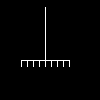 |
Rakes. Similar in meaning to the comb, rakes have the additional reference to the harvest. |
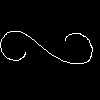 |
Bends. Signify defense or protection. |
 |
Spirals. The mystery of life and death is portrayed by spirals since they denote divinity or immortality. |
![]() Cross. Even in ancient times amongst the
Ukrainians, the cross was revered as a symbol of life. There are many
variations of the cross in pysanka design. They are always symbolic of
the Christian faith.
Cross. Even in ancient times amongst the
Ukrainians, the cross was revered as a symbol of life. There are many
variations of the cross in pysanka design. They are always symbolic of
the Christian faith.
![]() Plant motifs. Compositions in which
plant motifs predominate fall under the category of spring, symbolizing the rebirth
of nature and life. These designs reflect the unrestrained longing
expressed by the dormant plants. These pysanky are talismanic not only
for the growth of plants but for the general well-being of humans as
well.
Plant motifs. Compositions in which
plant motifs predominate fall under the category of spring, symbolizing the rebirth
of nature and life. These designs reflect the unrestrained longing
expressed by the dormant plants. These pysanky are talismanic not only
for the growth of plants but for the general well-being of humans as
well.
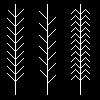 |
Pine Tree. This motif was known in the Tripillian culture and is common to most parts of Ukraine. Its qualities of permanent greenery and endurance symbolize strength, boldness, growth and eternal life. |
 |
Broad Leafed or Deciduous Tree. Known as the tree of life, this design is a symbol of renewal, creation and organic unity. It is usually surrounded by stags or birds, often both. Common to many cultures, this representation is seen throughout the world. |
 |
Apple Tree. This is a beautiful example of stylized plant representation. Very contemporary in design, it is, nevertheless, a pre-Christian ideogram. Other orchard trees such as the pear or plum are occasionally seen as well. |
 |
Willow Branch. In the Ukrainian religion, the Willow branch is traditionally blessed on Palm Sunday. There was an ancient belief that the sun was held in the sky on a large willow. |
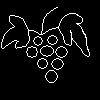 |
Grape Wine. This motif symbolizes continuity, good fellowship and strong, loyal love. Representing the wine of the Holy Communion, it also denotes the love of God and of Christ for mankind. |
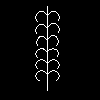 |
Apples or Plums. These orchard motifs denote knowledge, health and wisdom. |
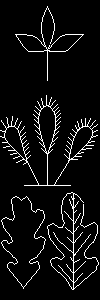 |
Three Leaf. This
ancient symbol denotes immortality and eternal love. The plant most
often stylized is the periwinkle which forms an integral part of spring and
wedding rituals. The traditional wedding wreath is fashioned from the periwinkle
plant, the sacred plant of Venus the goddess of love. Like the
evergreen, it retains its green color year round. From the Christian viewpoint,
it symbolized pure love and the eternity of the Holy Trinity.
|
 |
Rose or Star. Used interchangeably
with the star motif, the rose is a predominant floral motif and occurs in
many varied forms. Some variations are highly stylized and
abstracted. This ideogram, is symbolic of the female principle, wisdom.
beauty and elegance.
Lily of the Valley. An early spring flower, the lily of the valley suggests purity and humility as typified in the young bride. Sunflower. An ancient floral symbol denoting the sun, this symbol signifies the love of God because of its intense love of light. It is allied with the concept of motherhood and, therefore, becomes a life symbol. Vase. This is a striking floral design predominantly from the region of Sokal'. This region also displays characteristic floral representations showing the whole flower. |
 |
Cucumber. Known since the pre-Christian era, the cucumber is a symbol of the preservation of life because of its ability to retain water. |
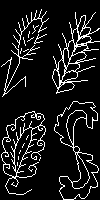 |
Ears of Cereal Plants. This is a beautiful example of stylized plant representation. Very contemporary in design, it is, nevertheless, a pre-Christian ideogram. Other orchard trees such as the pear or plum are occasionally seen as well. |
![]() Animal motifs. Motifs based on
zoomorphic representation are not as commonly used as are other categories.
Generally speaking designs from the Carpathian mountain region of western
Ukraine use these motifs along with geometric forms. Their use
reflects the close association of the mountainous peoples with their natural
surroundings. Many of these motifs were in use during pre-Christian
times.
Animal motifs. Motifs based on
zoomorphic representation are not as commonly used as are other categories.
Generally speaking designs from the Carpathian mountain region of western
Ukraine use these motifs along with geometric forms. Their use
reflects the close association of the mountainous peoples with their natural
surroundings. Many of these motifs were in use during pre-Christian
times.
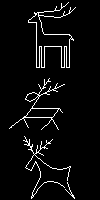 |
Stag. An ancient ideogram dating back to the Trypilljan culture, the stag signifies leadership, victory, joy and masculinity. |
 |
Horse. The horse appears as the ancient sign of the sun. Archeologists claim that the horse was first domesticated in Ukraine. This motif symbolize wealth or prosperity, endurance and speed; it also emphasizes the motion of the sun. |
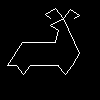 |
Ram. Chiefly a male symbol, it represents leadership and strength in the face of opposition. The popular motif of numerous variations also suggests perseverance and dignity. |
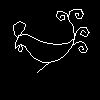 |
Rooster. This motif is considered a talisman of coming good fortune. In ancient times, it was related to the coming of the sun. It also denotes exultation and vigilance. As a symbol of masculinity, it predicts a rich married life with the blessing of many children. |
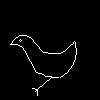 |
Hen. Symbolic of fertility, the revered hen is the bearer of the talismanic egg. |
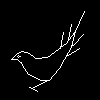 |
Birds. Many different species of birds were considered to be harbingers of spring. The swallow foretold the coming of spring to the householder; the stork symbolized the coming of new babies; the lark brought spring into the fields; the nightingale announced it to the orchards; while ducks and geese were precursors of spring to the lakes and rivers. |
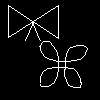 |
Butterfly. Representing the pleasure and frivolity of childhood, the butterfly motif suggests the ascent of the soul into immortality. It also reminds us that things of delicate beauty must take their own course rather than be contained. |
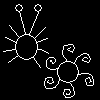 |
Spider. This ideogram was first seen as a variation of the sun motif with projecting strokes or rays. It symbolizes patience, artistry and industry. |
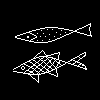 |
Fish. The fish, a symbol of Christianity, suggests abundance, baptism, regenerative powers and sacrifice. |
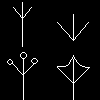 |
Hen's feet. This is a delightful motif which stresses protection of the earth toward her young. They also denote guidance or direction of the young in their search for knowledge. Goose Feet. These represent the soul or spirit as well as giving an intimation of warning of wakefulness. |
 |
Horns. This motif suggests nobility, wisdom and triumph over problems. There is also an implication of manhood and leadership. |
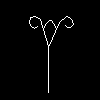 |
Ram Horns. Strong leadership or further strength in the face of opposition as well as perseverance and dignity are suggested by this motif. |
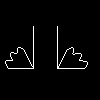 |
Bear's Paws. The bear was associated with the forest guardian spirit and this motif speaks of bravery, wisdom, strength and endurance as well as the coming of the spring. It also suggests a protective concept and is associated with the master of a home. |
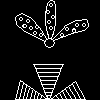 |
Rabbit's Ears. This ideogram denotes the humility of man as he attentively listens to the lessons offered by nature. |
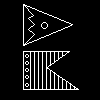 |
Wolves Teeth. Wolves teeth denote loyalty, wisdom and a firm grip. So strong was the talismanic belief in their power that wolves' teeth were given as amulets to both children and adults to help teething and to prevent toothaches. |
 Symbolism of Color...
The
colors used in pysanka design are steeped in symbolism. The most magical
ancient pysanky were considered to be those having four or five colors, each carrying
a message of good will for the recipient such as happy family life, peace,
love, good health, or success.
Symbolism of Color...
The
colors used in pysanka design are steeped in symbolism. The most magical
ancient pysanky were considered to be those having four or five colors, each carrying
a message of good will for the recipient such as happy family life, peace,
love, good health, or success.
|
Black
Said to represent the absolute, constancy, eternity or the womb, black may also denote death. |
|
White
Purity, virginity, innocence, and birth, are symbolized with this color. |
|
Yellow
The symbol of light and purity. It speaks of youth, happiness, the harvest, hospitality, love and benevolence. It is the color consecrated to the light deities and is the Christian symbol of recognition and reward. |
|
Orange
Symbolic or endurance, strength and worthy ambition, orange is the color of fire and flame. It represents the red of passion tempered by the yellow of wisdom. It is the symbol of the golden, everlasting sun. |
|
Green
As seen in the spring renewals, green symbolizes the breaking of shackles, freedom from bondage. It is the color of fertility, freshness, health and hopefulness. In the Christian context, it represents bountifulness, hope and the victory of life over death. It is the color of Christmas, Easter and Epiphany. |
|
Red
The magical color of folklore, red is considered a positive color signifying action, fire, charity, spiritual awakening. It also glorifies the sun and the joy of life and love. Consequently, pysanky with red fields or motifs are typically designated for children or youth. In the Christian symbolism, it denotes the divine love and passion of Christ. |
|
Brown
Brown is symbolic of the mother earth, bringing forth her bountiful gifts. |
|
Blue
Blue is used sparingly. It signifies the blue skies or the life-giving air and is a talisman of good health. Also symbolizes truth, fidelity, higher life and trust. |
|
Purple
When used in pysanka ornamentation, purple speaks of fasting, faith, patience and trust. |